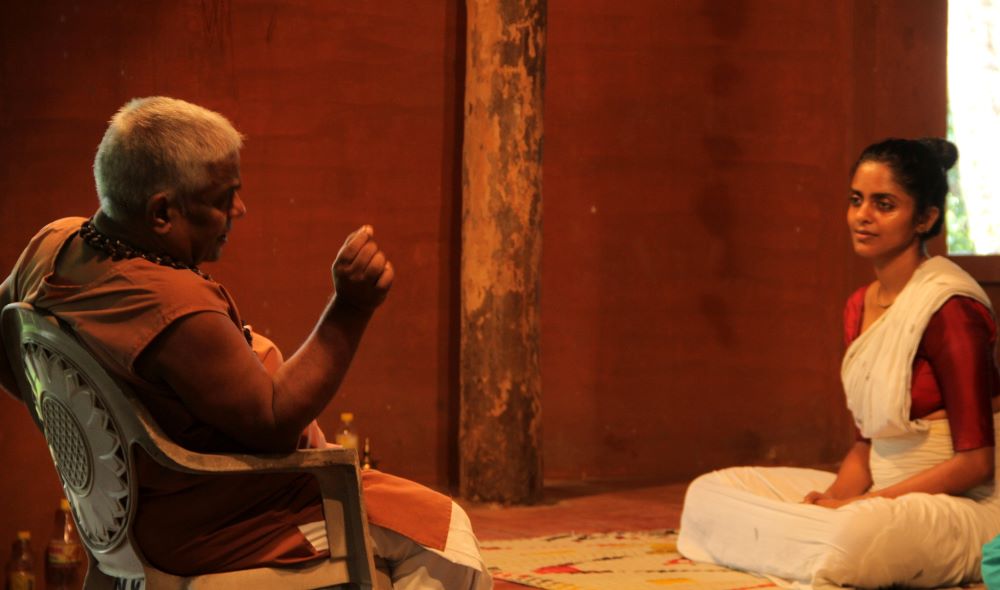Actor training programme Navarasa Sadhana celebrates milestone as alumni shine at Cannes 2024.
When the 112th edition of Navarasa Sadhana recently concluded at Natanakairali, Irinjalakuda, Guru G. Venu had special reason for celebration. As his new students showcased their artistic talents at the Kottichetam stage, some of his former students were making headlines by winning the prestigious Grand Prix at Cannes 2024. Actors Kani Kusruti and Hridhu Haroo from “All We Imagine as Light (the film that won the Grand Prix, the festival’s second highest prize—a first for an Indian film), and Mita Vashisht from “The Shameless,” which premiered at Cannes, were all trained through various editions of Navarasa Sadhana, a unique actor training program.
Since its inception in 2016, Navarasa Sadhana has attracted performing artists from across India and abroad. The completion of 112 batches underlines the program’s effectiveness. Designed by G. Venu, a Kutiyattam scholar, performer, and acting trainer, Navarasa Sadhana is rooted in the ancient treatise of Natya Shastra and indigenous actor training methodologies developed in Kerala. This program is designed to have systematically and daily practices the Nine Rasas, aiming to enhance actors’ abilities to evoke these aesthetic experiences in their audiences.
Evoking nine rasas
Sage Bharata’s Natya Shastra includes eight Rasas: Sringara (erotic), Hasya (comic), Karuna (pathetic), Roudra (furious), Vira (heroic), Bhayanaka (terrible), Bibhatsa (odious), and Adbhuta (marvelous). A ninth Rasa, Santa (tranquility), was later added, forming the Navarasa. According to Natya Shastra, Bhavas are divided into three categories: the eight Sthayi Bhavas (permanent states), the 33 Vyabhichari Bhavas (transitory states), and the eight Satvika Bhavas (internal emotions manifested). These categories include Nirveda (self-disparagement), Glani (debility), Sanka (apprehension), and Satvika Bhavas such as Stambham (paralysis), Swedam (sweating), and Romancham (horripilation).
These classifications, defined centuries ago, remain unchanged due to their meticulous analysis and study. Navarasa Sadhana enhances the acting methodology through systematic practice of the nine basic emotions, drawing from Kutiyattam, Natya Shastra, and Venu’s decades of study into three generations of Kodungallur royal family scholars.
The training that focusses on the control of lip exercises was available from the Kodungallur tradition through Venu’s guru and koodiyattam exponent Ammannur Madhava Chakyar. The bhava-s are according to Bharata’s formula of ‘Vibhavanubhavavyabhi charisamyogadrasanishpathih. When the actor is expressing a particular bhava, he/she should conceive the clear idea behind that rasa in his/her mind. They should understand the natural flow of breath associated with each bhava. There are exercises that help to identify these bhava-s from our routine life. Additionally, students are meticulously taught traditional acting techniques with Mudras, connecting Lokadharmi (realistic) and Natyadharmi (stylized) modes, and incorporating some techniques of Kutiyattam.
Intricacies of eye expressions
The program also explores Netrabhinaya, or eye expressions, and nine gestures of the eyeball, areas previously unexplored by scholars and thespians. The eye gestures include Brahmana (turning round the eyeballs at random), Valana (moving the eyeballs obliquely), Paatana (relaxing the eyeballs), Chalana (tremor of eyeballs), Sampravesana (drawing the eyeballs in), Vivartana (turning the eyeballs in a sidelong glance), Samudrutta (raising up the eyeballs) Nishkramana (going out of eyeballs) and Prakruta (eyeballs in the natural glance). Venu’s extensive research, including a three-year study on ‘Netra and Hasta’ involving consultations with all living masters of Kerala, has been instrumental in developing Navarasa Sadhana. The techniques for Eye Training incorporates those linking the eye and the breath.
Navarasa Sadhana has been codified to allow performers from various genres to incorporate the practice of the nine Rasas into their routines. To date performers and artists from genres including Kutiyattam, Bharatanatyam, Kathak, Kuchipudi, Mohiniyattam, Theatre, and Cinema have participated in Navarasa Sadhana training, illustrating its broad applicability and acceptance.


4 Comments
Wish to be a student there ,after our return from US on June 24th,2024 .
Thank you
Dear Francis, For more details on the next workshop, please contact navarasasadhanaworkshop@gmail.com
Wish to be student there.We are from Thrissur